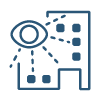Utility-Enabled Whole Building Data Access: The Problems, Processes and Possibilities
(A Series)
Part Two: The Processes
Building energy consumption is an unsolved problem at scale because it takes baseline data to drive meaningful change in a building. Leveraging utility data is the key, but easy, consistent access has stalled progress for years. This blog series explores the barriers, approaches, and benefits to utility-enabled whole building data access.
The Barriers to Access: Utility Processes Today
As described earlier, many buildings don’t fit into a simple, single unit, owner-occupied data request scenario. As a result, it’s difficult for utilities to get them data – here’s why:
![]() Barrier 1 – Utilities don’t store the notion of a building. So, while they have the customer and meter information, they don’t automatically recognize which of their customers reside in any given building. Buildings have never mattered to their business model, so it’s not data they have.
Barrier 1 – Utilities don’t store the notion of a building. So, while they have the customer and meter information, they don’t automatically recognize which of their customers reside in any given building. Buildings have never mattered to their business model, so it’s not data they have.
![]() Barrier 2 – Not everyone requesting data is an account-holding customer. They can be building managers, energy efficiency consultants, and non-occupant owners. These stakeholders need data to make informed decisions, but they can’t get it through a customer-only portal. They also aren’t personas utilities consider in success or satisfaction metrics.
Barrier 2 – Not everyone requesting data is an account-holding customer. They can be building managers, energy efficiency consultants, and non-occupant owners. These stakeholders need data to make informed decisions, but they can’t get it through a customer-only portal. They also aren’t personas utilities consider in success or satisfaction metrics.
![]() Barrier 3 – Buildings don’t always align with customer segments and program design, because many don’t fall into typical utility C&I, SMB or residential categories. Buildings often blur the lines between residential and commercial, which means solutions to building-related issues don’t map to existing utility teams or operations.
Barrier 3 – Buildings don’t always align with customer segments and program design, because many don’t fall into typical utility C&I, SMB or residential categories. Buildings often blur the lines between residential and commercial, which means solutions to building-related issues don’t map to existing utility teams or operations.
The result of all these barriers? In many cases, multi-tenant building data isn’t available from utilities. Where it is, the process is often manual and time-consuming for all. But to evaluate efficiency potential and more, and to comply with increasingly thorough building-focused energy policies, the building sector needs reliable, easy access to accurate data for all buildings. Luckily, a successful model for utility-enabled whole building data access exists, and it’s beneficial to all involved.
The Proven Model
The following approach is currently live with multiple investor-owned utilities, allowing building owners and operators of all types of facilities to get the usage data they need.
Utilities generally implement solutions in response to benchmarking ordinances, building performance standards, and non-mandatory incentives and contests. Any of those can catalyze enough requests for building level data to create operational challenges for utilities responding. We’ve also seen slow but steady evolution in utilities understanding the value of building data for their own programs and priorities.
Whatever the initial drivers are for a solution, the trajectory of external catalysts and internal advantages is clear: buildings are becoming energy assets under management. And over time utilities will be contributors to, participants in and beneficiaries of that management.
Calico’s Building Data Solution provides a secure way for building owners or operators to access their data and manage their energy usage while leveraging the ENERGY STAR ® program for benchmarking if they desire. Over 12,000 buildings use the solution to request and receive their data.
“Benchmarking is a win-win; it unlocks the saving potentials for so many customers across the Midwest and speaks to the cumulative savings and not just for those ready to comply but those looking to drive change. For customers, it’s the gateway to energy efficiency.”
– Utility building benchmarking program manager
Owners and operators can:

1. Establish their right to access.

2. Request building level data.

3. Establish their right to access.

4. Receive aggregated data.

5. Download/share/use that data as they see fit.
Making it Happen: Practical Advice
The model sounds simple, but it requires new thinking. Here’s what utilities and involved entities can do:
- Take a customer-status agnostic approach. This approach makes it possible for approved building representatives (from managers to energy efficiency consultants to non-resident owners) to get the data they need. They will not all be utility account holders. And more – when utilities know who the right contact is for energy management in a building, they have the right lead for their own EE and incentive programs.
- Leverage building owner knowledge and utility data. Building owners know their units and who their tenants are/were better than a utility ever could. A software-enabled approach that combines utility data and building owner knowledge is an elegant way to get accurate data into building owner hands while maintaining privacy. It also gives everyone the assurance that the data is accurate.
- Get involved with the stakeholder community. Whether you’re a utility program manager facing a new ordinance, a legislator, or a city official trying to reduce energy consumption in buildings, there are groups eager to work with you on this problem. Organizations like MEEA, ACEEE, and IMT are committed to providing best practices and helping regions shape effective building-focused legislation.
Want more information?
Stay tuned to part three of our series Utility-Enabled Whole Building Data Access: The Possibilities to learn more.
Can’t wait? Download Calico Energy’s Playbook: Utility-Enabled Whole Building Data Access: The Problems, Processes and Possibilities
Check out the latest from our blog…
Interested in learning more about Calico's team?
Looking for additional resources?
Head to our Resources page for more industry perspectives and product information.